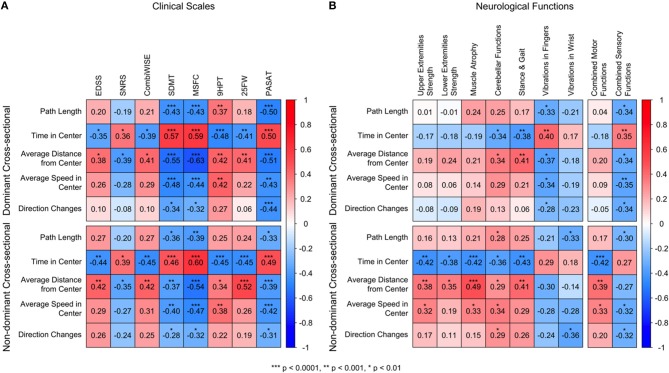Figure 3.
Correlation matrices against clinical scales and neurological functions. (A) Spearman correlations of the Level features against eight clinical scales: Expanded Disability Status Scale [EDSS (1)], Scripps Neurological Rating Scale [SNRS; (11)], Combinatorial Weight-Adjusted Disability Score [CombiWISE; (4)], Symbol Digit Modalities Test [SDMT; (2)], Multiple Sclerosis Functional Composite [MSFC; (12)], 9-Hole Peg Test (9HPT), 25-Foot Walk (25FW), Paced Auditory Serial Addition Test (PASAT). The 9HPT scores use the dominant/non-dominant hand score. (B) Spearman correlations of the Level features against neurological features. The Stance and Gait scores use the entire body score. The following functions use the dominant/non-dominant side score: Upper Extremities Strength, Lower Extremities Strength, Muscle Atrophy, Cerebellar Functions, Vibration in Fingers, and Vibration in Wrist. For all correlations red colors correspond to positive correlations, and blue colors correspond to negative correlations. All p-values are adjusted column-wise using false discovery rate and are categorized as ***p < 0.0001, **p < 0.001, *p < 0.01. The time in center and average distance from center, for both dominant and non-dominant hands, had strong, significant correlations with all 8 analyzed clinical scales. The strongest correlations were observed for cognitive scales SDMT and PASAT and the composite scale MSFC. The remaining Level features also correlated with cognitive scales and MSFC, even though the strengths were overall lower. The correlations with clinical scales were comparable for dominant and non-dominant hands.

